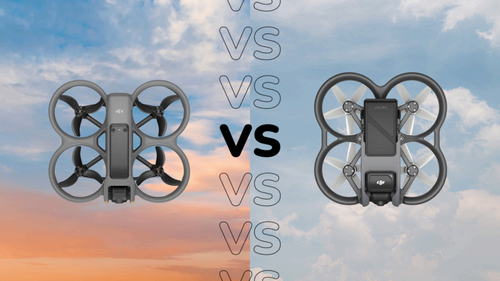
DJI recently announced its newest FPV drone and successor to the DJI Avata, the DJI Avata 2.
The Avata 2 arrives nearly two years after the beginner-friendly FPV drone first landed on shelves in August 2022 and is designed to be paired with DJI’s new DJI Goggles 3 and DJI RC Motion 3. The drone brings an upgraded sensor and increased flight time to the series, among other updates.
Keep reading to discover all the biggest differences between the DJI Avata and the DJI Avata 2.
The DJI Avata 2 delivers better image quality
DJI has fitted the Avata 2 with a larger image sensor than its predecessor, giving the drone the edge when it comes to image quality.
The Avata 2 packs a 1/1.3-inch CMOS sensor that enables a wider dynamic range and improved performance in low-light conditions. The sensor is paired with an ultra-wide-angle lens with a 155-degree viewing angle for immersive aerial photography.
The camera is capable of capturing HDR video at up to 4K/60fps, or slow-motion content at 2.7K/100fps. The Avata 2 also includes a 10-bit D-Log M Color Mode for colour grading.
The original DJI Avata is equipped with a larger 1/1.7-inch CMOS sensor with the same 155-degree viewing angle. The drone also supports the same 4K/60fps resolution, or 2.7K/120fps slow-motion video when paired with the DJI Googles 2 or FPV Goggles V2.
The DJI Avata 2 can fly for longer
The DJI Avata 2 has a longer flight time than its predecessor, allowing it to remain airborne for up to 23 minutes. The DJI Avata has a shorter flight time of 18 minutes, meaning the Avata 2 has the edge by about five minutes.
The Avata 2 also supports PD fast charging, meaning you shouldn’t need to wait long between charges to take flight once again.
The drone is also compatible with DJI’s new Two-Way Charging Hub, which makes it possible to transfer the remaining power from multiple batteries to the battery with the highest charge level at that moment.
The DJI Avata 2 has an increased transmission range
The DJI Avata 2 supports up to 13km of maximum transmission distance, along with a transmission latency as low as 24ms. This is with 1080/100fps image quality and a maximum transmission bitrate of 60Mbps.
The original Avata is capable of transmitting video up to 10km with the lowest possible latency being 28ms for 810p/120fps video with the FPV Goggles V2. The latency increases to 30ms for 1080p/100fps video with the Goggles 2. The maximum video transmission bitrate is 50Mbps.
The DJI Avata 2 has updated safety measures
The DJI Avata 2’s integrated propeller guard is lighter and more agile than than on its predecessor. This makes the drone more adept at navigating tight spaces.
Like the DJI Avata, the Avata 2 also has a Turtle Mode, which automatically flips the drone back into its takeoff position if it lands on its back.

